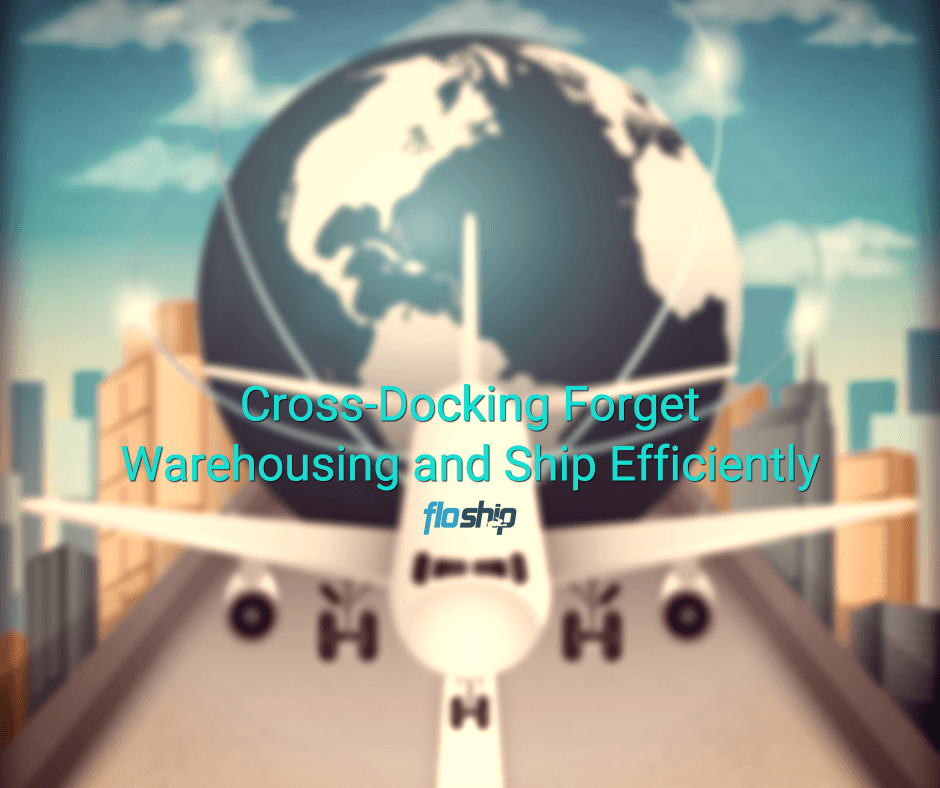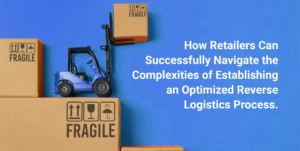“By reducing reliance on inventory buffers and expediting customer orders, cross-docking promotes a flow-through supply-chain pipeline.”
— Ray Kulwiec, Crossdocking as a Supply Chain Strategy
WHAT IS CROSS-DOCKING?
In a competitive market like logistics, it is essential to satisfy your customer needs and improve your competitive advantages and crosss-docking is one of the logistics strategies that can help you achieve that:
Cross docking is a form of freight movement whereby raw, partial components or finished products from a supplier or manufacturer are distributed directly to the users, which include the next level manufacturers, or end consumers, with minimal or no storage time.
When part of a global logistics network it allows for more competitive rates and to the streamlining of shipping.
As you may see from the graph below, inventory warehouses act as a buffer against increased demand in a traditional supply-chain model.
Yet the advancement of technology enabling real-time information exchange and analysis has made it possible now to shorten the cushion of supply inventory on hand, such as just in time (JIT) stocking, which enhances a companies operations and inventory efficiency–allowing for less capital to be tied up in inventory.

Cross docking takes place in the cross dock terminal which is a minimal space that consists of the inbound and outbound docks, usually in a warehouse environment.
Once the inbound transportation (semi-trailer truck, railroad car, etc) has been docked, products can then be unloaded to the terminal; they then can be screened and sorted to identify its end destinations; afterwards, products will be reloaded to the outbound dock via forklift, conveyor belt, pallet truck or other means of tools before trucks, trailers, rail cars or other means of transportation deliver the parcels to customers. The products usually spend less than 24 hours at the terminal, sometimes even less than an hour.
 (source: ERAU)
(source: ERAU)
In simpler terms, cross-docking could be thought of as a hub , or spoke and wheel, network of distribution (see above image) like many airlines you may be familiar with use, for example United Airlines in Guam, Cathay Pacific in Hong Kong both use a hub and spoke model for their airline logistics.
The reason a hub airport is preferred by airline companies is because it allows airlines to connect with the maximum amount of destinations with the minimum number of routes compared with a point-to-point model.
For the same reason, cross dock is a transportation-optimized solution that provides significant cost saving for the company.
Advantages and Disadvantages of Cross Dock Solutions
So how does a company decide whether cross-docking is the right fit for its logistics strategy? Here is a list of advantages and disadvantages of cross-docking to assist the decision process.
Advantages of Cross Docking Include:
-
Material Handling
- At the cross docking terminal, material handling will be streamlined and therefore efficiency will be greatly improved (i.e. in-motion labeling, in-motion weighing, label verification, destination scan, etc.)
-
No Need for Warehouse
- In many cases, the traditional warehouses will be replaced by the cross dock facility, which is easier to construct and requires less square footage, and, hence–provides both variable and fixed asset cost savings for a company. When using a 3PL for cross-docking, in a case like Kickstarter or Indiegogo fulfillment, most cross docking companies maintain a dedicated cross dock warehouse.
-
Packaging and Storing Cost
- The storing cost will be reduced because, well with this method inventory’s time in a warehouse should be minimal, and the extra packaging cost will also decrease due to automation practice in the cross-docking terminal.
-
Transportation and Distribution Cost
- Since products destined for a similar end point can be transported together, there will be full loads for each transportation trip and thus drive down the transportation costs in scale. Additionally, as the routing is now optimized (hub and spoke) with the elimination of unnecessary processes like “pick-location” or “order picking”, less miles will be wasted and therefore fuel and associated vehicle service costs will be driven down.
-
Products Screened More Quickly
- Products will be screened more efficiently with the application of streamline and automation at the terminals, this can greatly reduced the time parcel spend in shipment.
-
Products Reach Customers Faster
- As a positive sequel to the accelerated screening process, there will be a high turnover of products which means that products can now be delivered sooner to the customers.
-
Less Risks for Inventory Handling
- Since a warehouse is no longer needed, concerns of inventory management risks are no longer necessary.
However, besides the upsides of cross-docking, one should also consider the relative risks and even prerequisites before steering your cross-docking strategy. Below are a couple of risks that we have identified.
Disadvantages of Cross-Docking to Consider:
-
Partners May not Have Storage Capacities
- Cross-docking helps cut cost with the elimination of warehouse, yet if the company’s potential partners do not have the necessary storage space, the inventory problem will be a burden for effectively implementing cross dock.
-
Freight Handling May Cause Product Damage
- As the cross dock is well calculated in order to implement, any additional freight handling may jam the system and cause damage amongst products.
-
Management and Attention Required
- Efforts to set up a cross-docking system cannot be overlooked. It takes time, planning and money to design for it to work effectively. In addition, labour costs are also inevitable for the moving and shipping of stocks at the terminal.
-
May not Deliver Right Product On Time
- Outbound users have to bear the risk that a supplier might not be able to deliver the right product in its right amount on time due to a systematic error.
Apart from the risks associated with cross dock for the supplying company, here are a few more prerequisites to check off the list:
-
Adequate Transport Carriers
- A sufficient amount of transportation fleet is needed in order for a cross dock to run smoothly as a large amount of its process depends on its shipping.
-
Computerized Logistics System
- It is very important to have an intelligent integrated system enabling suppliers to keep abreast of the latest point-of-sale information (i.e. sales activities and trends) which offers insight of future orders. For instance, Wal-Mart with 85% of its merchandise using cross-docking operation, is known to use a private satellite communication system to transmit its real-time information to the users.
-
High Volume to be Cost Effective
- Economies of scale also applies here. High amount of products can drive down costs including operating costs and transportation costs.
WHEN TO USE CROSS-DOCKING?
-
Stable Demand Inventory
- With a stable product demand, a consistent schedule and system can be set up to accommodate the recurring delivery, and can be improved to cut costs further with effective analysis once generated enough data. In addition, it eliminates the needs of surplus inventory to be stored in case of out of stock situation.
-
Time-Sensitive and Perishable Inventory
- Due to the sensitivity of time, the products (i.e. grocery) need to reach the users in a reasonable remaining shelf time. Through bypassing the step of storage and delivering directly through cross dock terminal, the time is reduced which gives more room for the limited shelf time, provides the products with longer sales window, and potentially offers better products and services for users.
-
Crowdfunding and E-commerce Flashsales
- When a crowdfunding campaign that raised money for products, like many on Indiegogo and Kickstarter, they are usually one off shipments to backers and the usual method of delivery involves crossdocking. In the same vein, when an e-commerce store has a flash sale or any big uptick in sales volume due to some special event–think Black Friday or Cyber Monday–then cross docking in usually the most cost effective way to deliver the inventory to the end user.
Are Cross Dock Operations Right for Your Products?
Cross-docking remains an essential strategy for various logistics challenges.
For crowdfunding fulfillment, rewards are shipped to a campaign’s Indiegogo or Kickstarter backers almost always via the cross docking method.
As the hub and spoke model shows, there are efficiency gains when shipping from a hub location.
This is one reason Hong Kong maintains a strategic advantage as an e-commerce distribution hub especially in the case of crossborder shipments out of China to the rest of the world: Hong Kong is the world’s largest by volume air freight hub.
And moreover, it makes Hong Kong the best place for e-commerce merchants to process, what–until recently–was Shenzhen fulfillment.
Learn More E-commerce and Shipping Concepts on the Floship Blog
- What Is Fueling The eCommerce Boom In China?
- Scaling Shopify – 3 Winning Tools to Skyrocket Your Store
- Can an Order Fulfillment Warehouse Reduce Your Overhead?
- Kickstarter vs Indiegogo: #1 Breakthrough Platform?
- 5 Common E-commerce Fulfillment Problems (And How to Fix Them)

Ready To Upgrade Your Logistic Solution?
Speak to Floship ecommerce logistic consultant about improving your global support chain today





